Find out all about the irrigation materials you need to optimise your crops.
In our specialised shops we have a wide range of professional products and tools designed to facilitate and improve irrigation systems for professional agriculture, gardening and water treatment:
From pipes and fittings to control systems and advanced technologies.
Get all irrigation components in our irrigation, garden and pool shops.
Irrigation Shops in Murcia
Irrigation Shops in Almería
Irrigation Shops in Ciudad Real
Irrigation Supplies
Fertiliser spreader
The fertiliser spreader is a tank (hermetically sealed) connected in parallel to the agricultural irrigation network. It consists of two outlets:
- One for the water inlet.
- Another for water and fertiliser outlet
The outlets are connected to the irrigation network at two points close to each other, but separated by a valve to create a pressure difference so that part of the irrigation water circulates through the parallel circuit where the tank is located.
Advantages of spreaders:
This is the simplest system for the application of fertilisers to irrigation water. It is only necessary to apply the required dose of fertiliser per irrigation (without mixing incompatible fertilisers).
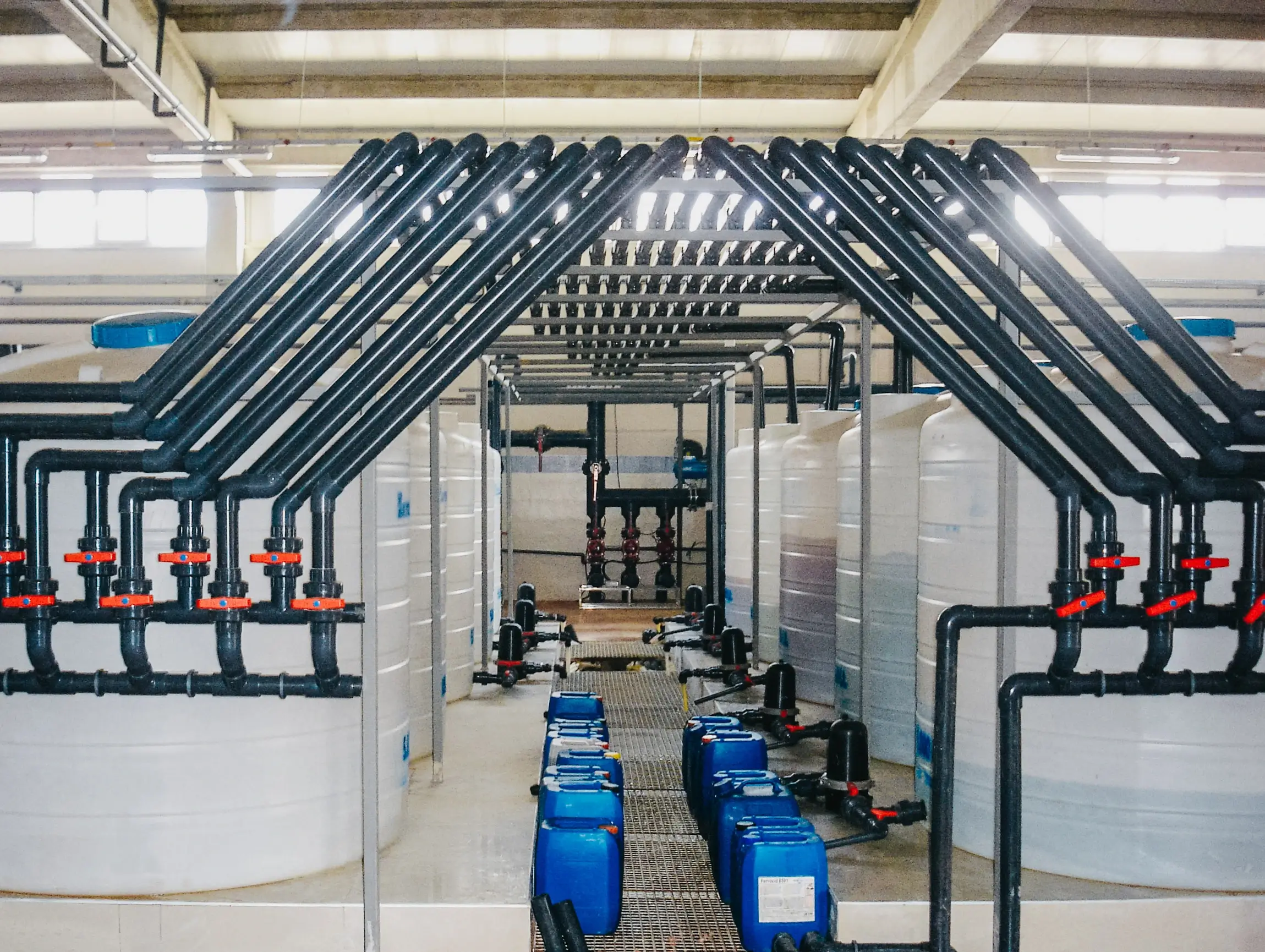
Agricultural irrigation sprinklers
They throw the sprayed water through a boom (with one or more nozzles) at distances of over 5 m. And they can distribute the water over the ground in 360-degree turns (depending on the type of sprinkler).
Types of irrigation sprinklers
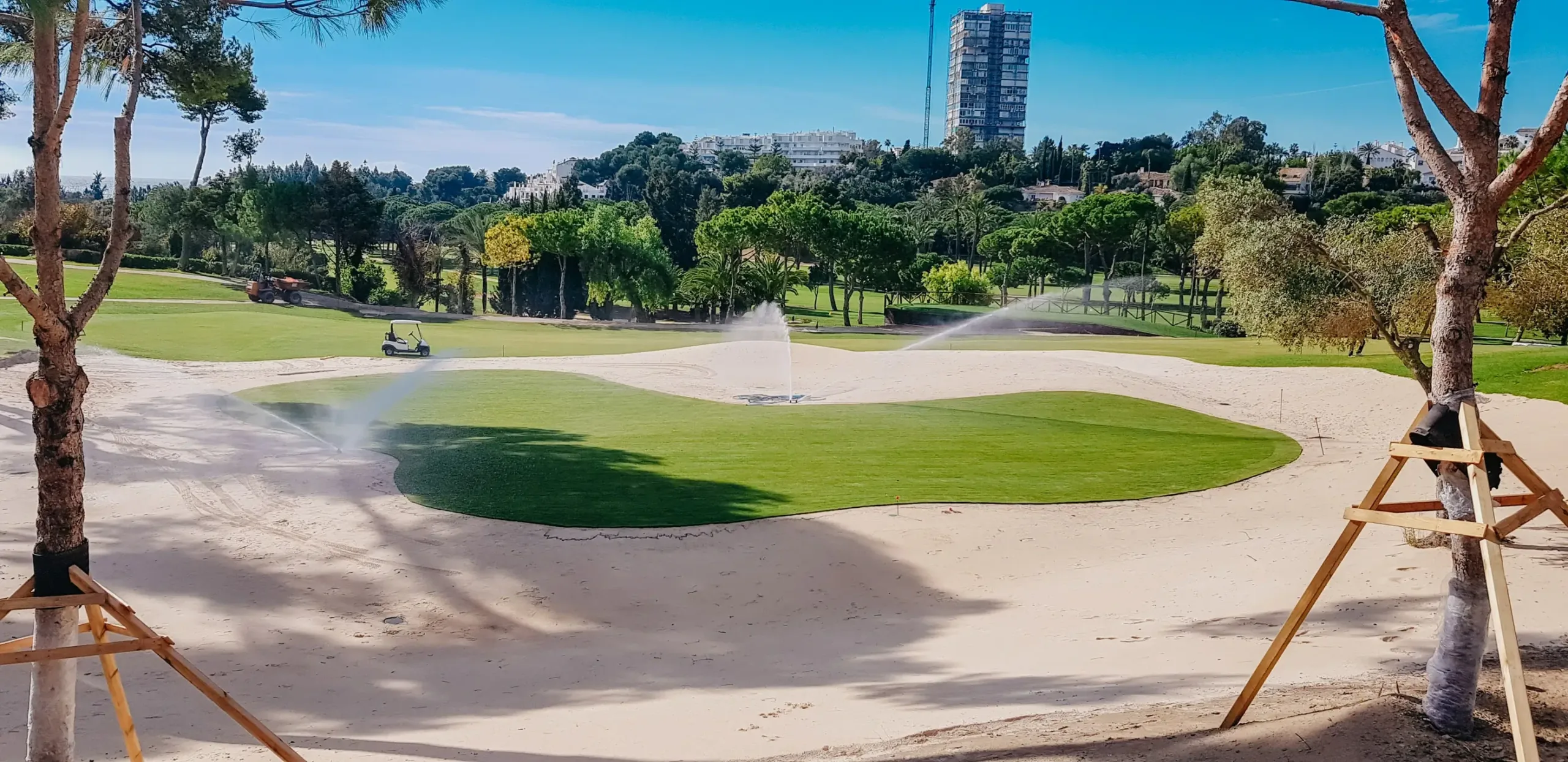
Pop-up sprinklers
The most commonly used in gardening. They are hidden under the soil and emerge from the ground to irrigate by water pressure.
Overhead sprinklers are classified according to:
The turning mechanism
Impact: the rotation is caused by the impact of the water exiting the nozzle on an oscillating arm, causing the sprinkler to rotate.
Turbine or geared: the water passes through a turbine or gear that rotates the sprinkler before exiting the nozzle.
Rotary or reaction: the inclination of the outlet orifice causes the rotation.
Overhead sprinklers
The most commonly used in gardening. They are hidden under the soil and emerge from the ground to irrigate by water pressure.
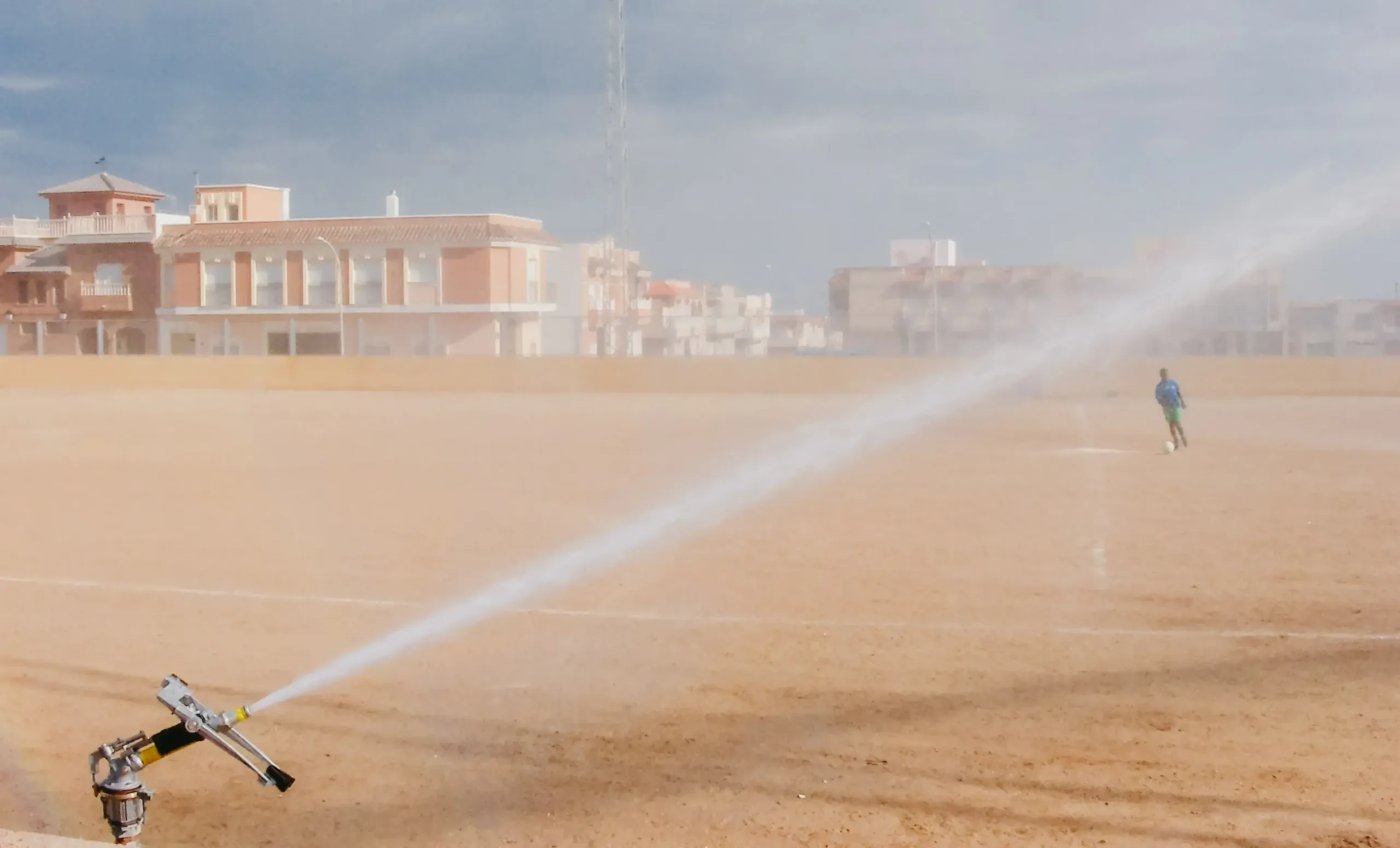
Depending on the wetted area
Circular: they make a continuous 360º turn. They are placed inside the plot to be irrigated.
Sectorial: they make a turn of less than 360º. They are installed on the edges of the plots to irrigate corners and sides.
corners and sides.
Pressure regulators
Pressure regulators are sprinkler accessories installed on the sprinkler pipes. They keep the pressure in a narrow range to avoid pressure fluctuations in the sprinkler installation.
This ensures uniformity of pressure between the different sprinklers.
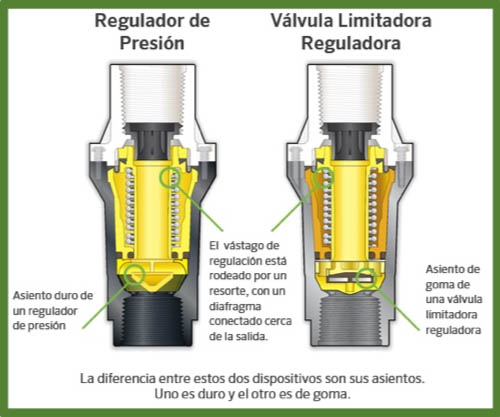
Agricultural irrigation pumps
The irrigation pump supplies the necessary flow to the irrigation system with the pressure required for proper operation.
Types of irrigation pumps
They are classified according to the energy source they require
Electric pumps
They operate by means of a single-phase (230v) or three-phase (400v) electric motor, depending on the power of the electric motor.
Types of irrigation pumps depending on the water suction head
The suction head is the level at which the pump is installed above the pipe mouth. A distinction is made between:
Submersible pumps
They are used in irrigation reservoirs to eliminate suction problems when the height is high.
They are installed on the surface of the reservoir (floats) or in an attached suction chamber.
Pump types according to the drive shaft
Horizontal pumps
They supply high flow rates and low pressures. They are the most common pumps installed in irrigation headers.c
Motor pumps
They are powered by a combustion engine. Petrol is used in the case of small horsepower motor pumps and diesel for those of higher power.
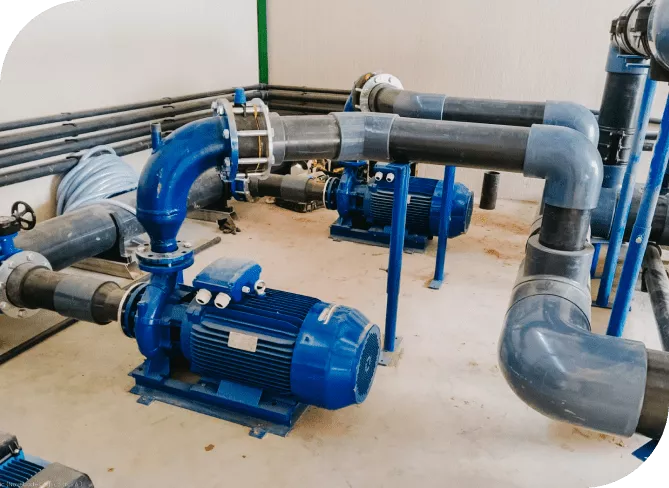
Non-submersible pumps
They are placed on the surface of the ground and are used when the suction height is low or lower than the mouth of the suction pipe.
Vertical pumps
They deliver high pressures.
Frequency inverter
Controls the speed of the pump motor according to the water demand required by the installation. This avoids high overpressure at the start of irrigation that causes water hammer in the pipes and minimises consumption by adjusting the flow rate to the needs of the irrigation sectors.
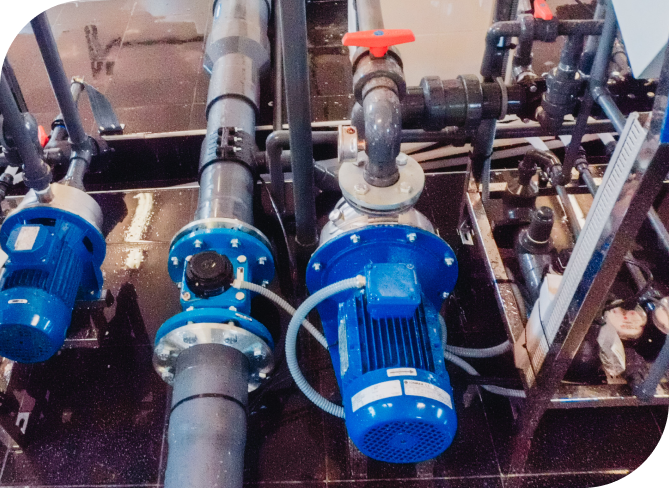
Agricultural irrigation sprinklers
Sprinkler heads are emitters (widely used in gardening) that distribute water in the form of drops or small jets in a fixed sector (they have no moving parts). They are suitable for narrow areas such as flower beds or shrubs. And they have a range of between 1.5 and 6 metres.
The regulation of the arc and irrigation sector adapts to your needs (with arcs of up to 360º).
Types of sprinkler heads
-
Overhead: the diffuser nozzle remains visible and is installed on a threaded adapter to the irrigation pipe.
-
Emergent: the nozzle nozzle emerges when irrigation is activated by water pressure and hides (at ground level) at the end of irrigation.
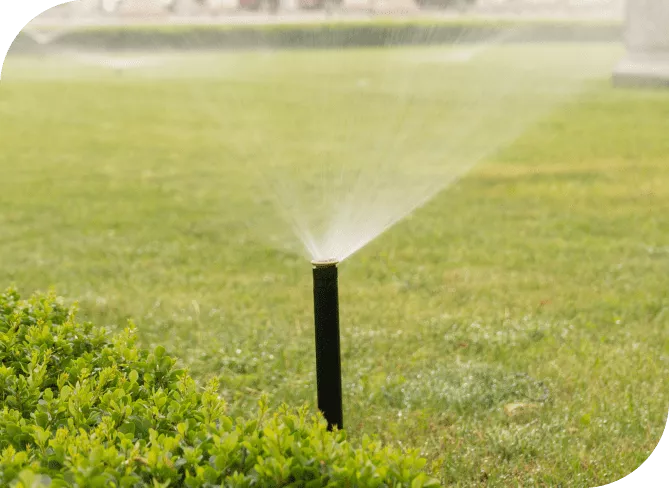
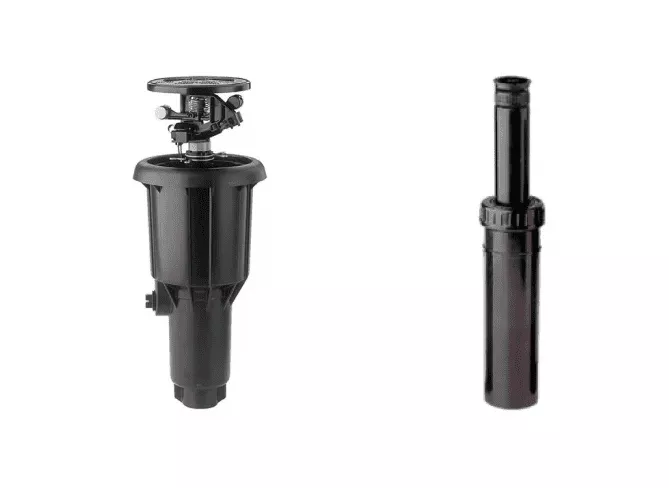
The spindle is raised and allows watering at different heights. It also incorporates anti-drainage valves (preventing the system from discharging) to reduce water consumption. It also has pressure regulators so that all nozzles supply the same flow rate.
Irrigation solenoid valves
It opens and closes the water flow through the pipe in an electrically controlled manner. And if a programmer is installed, it can be automated.
Components of solenoid valves A solenoid valve consists of two elements:
-
The solenoid: is a copper coil that resembles a magnet when carrying a current. Thus, a ferromagnetic moving core is attracted to the coil when a current flows.
-
The valve: allows or prevents the passage of water by the action of the solenoid.
Operation of solenoid valves
-
Closed: when there is no power supply, they are closed. When the solenoid is energised, it moves its ferromagnetic core and causes water to flow in, which lifts the closing element of the valve and opens it.
-
Open: remain open when there is no power supply.
You can find them in the impulsion section of a pump (avoids the discharge of the system). And at the inlet to the irrigation sectors to irrigate them individually.
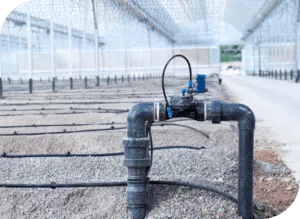
Filters for drip irrigation
The main problem of the drip irrigation installation is the clogging of the emitters. To prevent this, filters are used to separate the particles contained in the irrigation water.
Types of drip irrigation filters
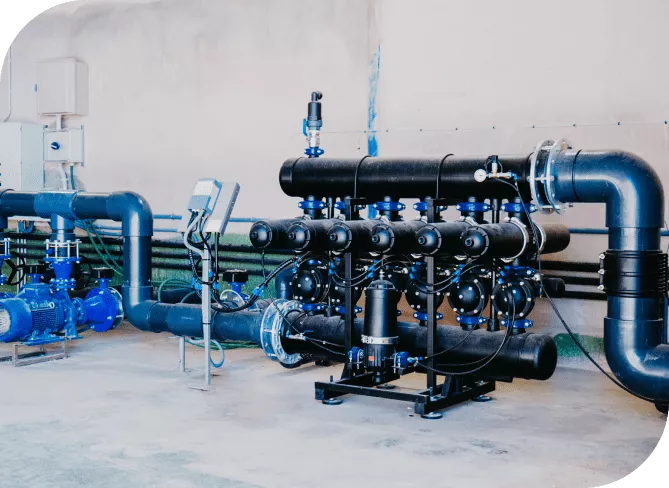
Area filters
They separate organic materials (algae) and large particles thanks to a thick layer of silica sand contained in the filter.
Hydrocyclones
They separate the particles by centrifugal force (by means of a vortex), so that the heavy particles move towards the walls and fall into a tank at the bottom.
particles move towards the walls and fall into a tank at the bottom. They are used when sands are in suspension (deep well casings).
Mesh filters
The water passes through a screen. Particles larger than the mesh openings are retained in the filter.
They are effective for slightly dirty water with materials of inorganic origin. They can be cleaned manually, semi-automatically or automatically.
Ring filters
The slotted rings are compressed against each other and form a filter cylinder. And when the water
water passes through the slots, the larger particles are trapped. They are used in medium to poor water quality. In addition, the rings can be of different diameters (each type of ring has an associated colour).
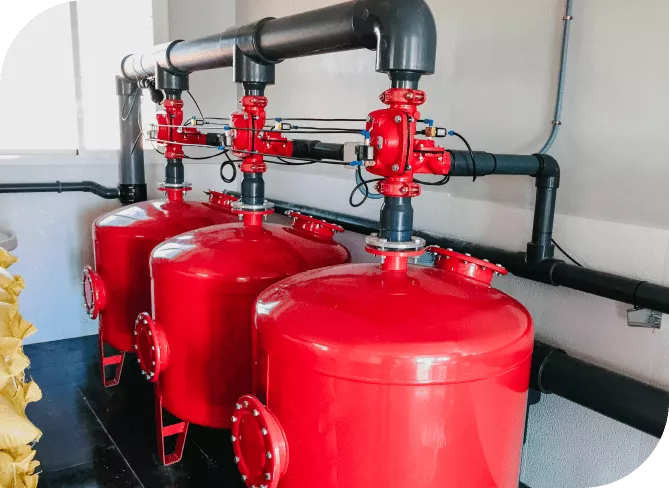
Drippers for agricultural irrigation
Punctured drippers
They are drippers installed in derivation or on line by inserting the dripper through the wall of the emitter pipe (button drippers).
Types of pricked drippers
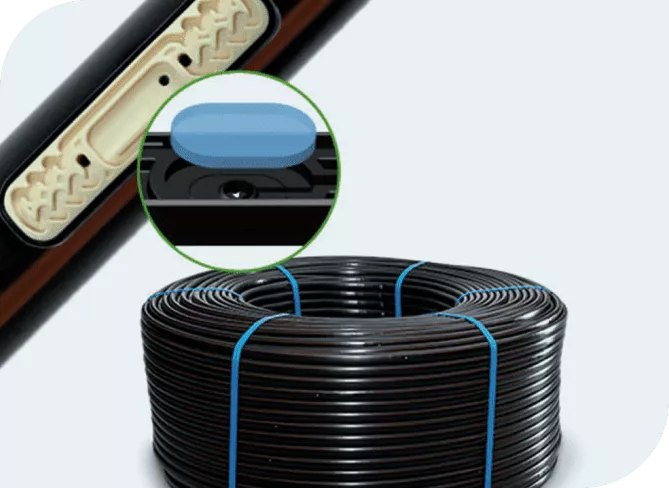
Adjustable drippers
They regulate the flow they provide.
Detachable drippers
They can be disassembled without removing the dripper part of the pipe.
Self-compensating drippers
They adjust the flow rate to the system pressure in order to maintain it within a given pressure range.
Anti-drain drippers
The dripper closes when the system pressure drops and prevents water from escaping when not irrigating.
Integrated or interline drippers
The dripper inserts or interline drippers are fitted into the interior of the pipe.
For this purpose, the emitter pipe is cut and the dripper is assembled in a watertight manner. And it is very easy to replace in case of breakage or clogging.
clogging. The drippers are installed in the pipe according to the requirements of your project, the type of crop and the planting pattern.
Integrated drippers
They have a diameter slightly larger than the inside diameter of the emitter holder pipe. They are inserted into the pipe during manufacture so that they remain fixed in a specific position.
Integrated flat drippers
They are thermowelded into the wall of the emitter holder pipe.
Advantages of Flat Drippers
- They reduce the risk of breakage due to mechanical damage (passing tractors, trampling, etc…).
- They avoid the risks of clogging as much as possible.
- They have a labyrinth that leads the water from the inside of the pipe to the opening.
Integrated dripper systems
Different models of integrated drippers may have one or more of these qualities:
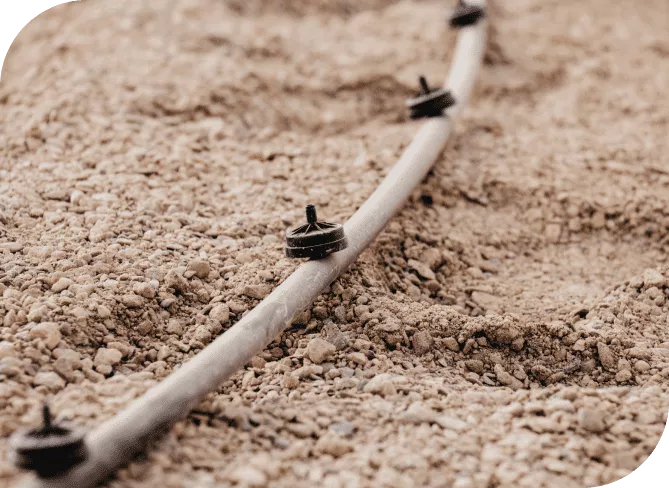
Self-compensating integrated drippers
They maintain the flow rate within a certain pressure range. It has a diaphragm that controls the water flow (it narrows the flow when the pressure increases and increases the flow when the pressure decreases).
Integrated anti-suction drippers
They shut off the water at the dripper outlet when the system pressure decreases, and prevent the suction of air, water and dirt.
suction of air, water and dirt.
Integrated anti-drainage drippers
They prevent the system from discharging when watering is finished.
Irrigation hoses
Irrigation hoses are flexible irrigation pipes (they take on the shape of a pipe when water under pressure passes through them and when it stops passing through them, they lie flat).
They are made of plastic fibres that better prevent the stresses caused by the water pressure inside them.
(Deployable in characteristics and technical specifications)
Advantages of irrigation hoses
Very easy to store, transport, install and operate.
Use of irrigation hoses
They are used as tertiary pipes in sprinkler irrigated horticultural and cereal crops.
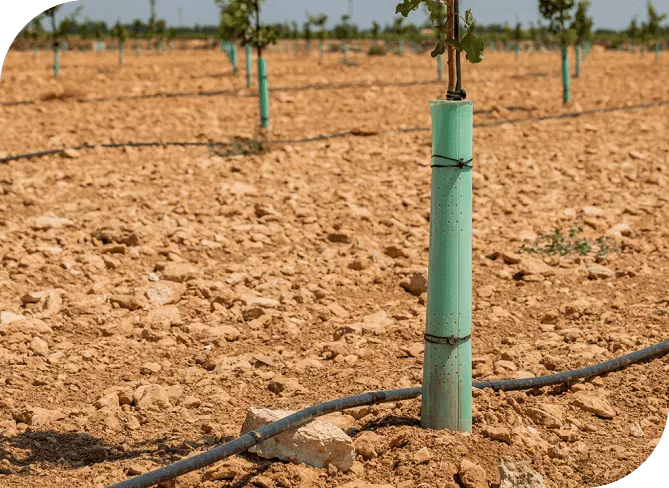
Irrigation emitters
Drip rubber bands or emitter pipes are installed on farms to insert the drippers. The number of drippers depends on the number of drippers:
-
The type of dripper and the flow rate it delivers.
-
Of the textures of the soil.
-
Water requirements of the crop.
-
The type of planting frame.
Types of dropper rubbers
-
Single emitter holder tubing: for pinched and inserted drippers.
-
Emitter pipes with integrated drippers.
-
Microtube: for micro-irrigation in hydroponic systems.
-
Irrigation tapes: perforated and shallowly buried pipes for applying irrigation.
-
Exudation or porous pipes: when water passes through the interior (at a certain pressure), it is supplied through the micropores on the surface.
You can find them in the impulsion section of a pump (avoids the discharge of the system). And at the inlet to the irrigation sectors to irrigate them individually.
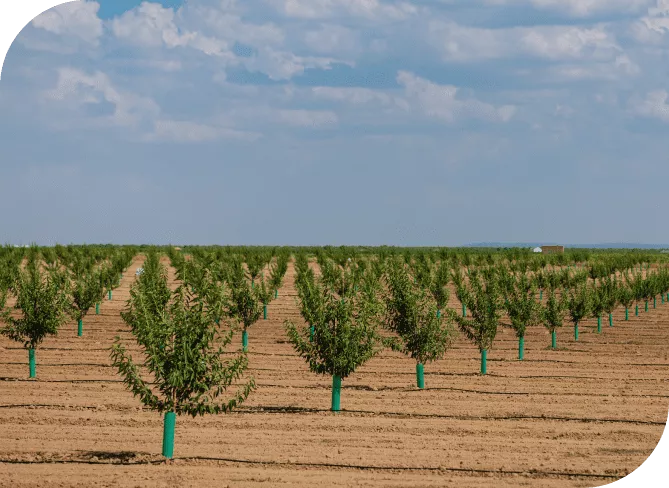
Micro-sprinklers
Depending on your needs and those of your crops, you can choose between different models of micro-sprinklers (differentiated by colour according to their flow rate).
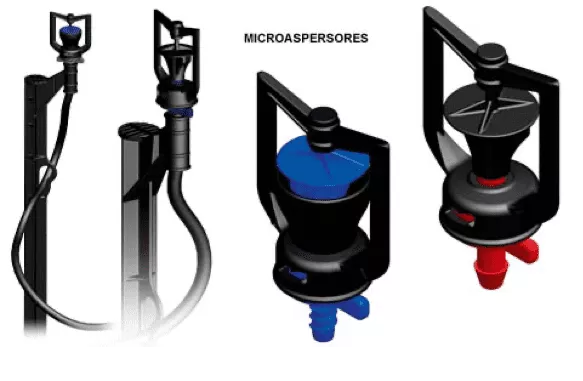
Types of micro-sprinklers by flow rate
Low flow
20-10l/h
For dense planting of horticultural crops in greenhouses, nurseries and seedbeds.
Average flow rate
50-80l/h
High flow rate
100-240 l/h
For horticultural greenhouse and outdoor tree plantations
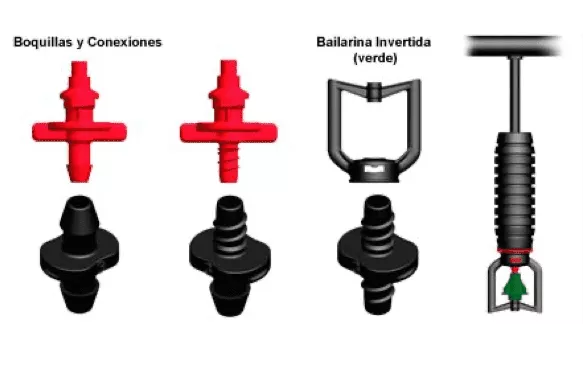
Nozzles
The most common type of nozzle is the dancer type. It is designed in a modular way, with interchangeable parts, and allows multiple combinations to adapt them to your installations.
Where are micro-sprinklers installed?
Inserted in the irrigation pipe
Hanging and connected by microtubes to the irrigation pipe.
Installed on stakes of different shapes and sizes that support them on the ground.
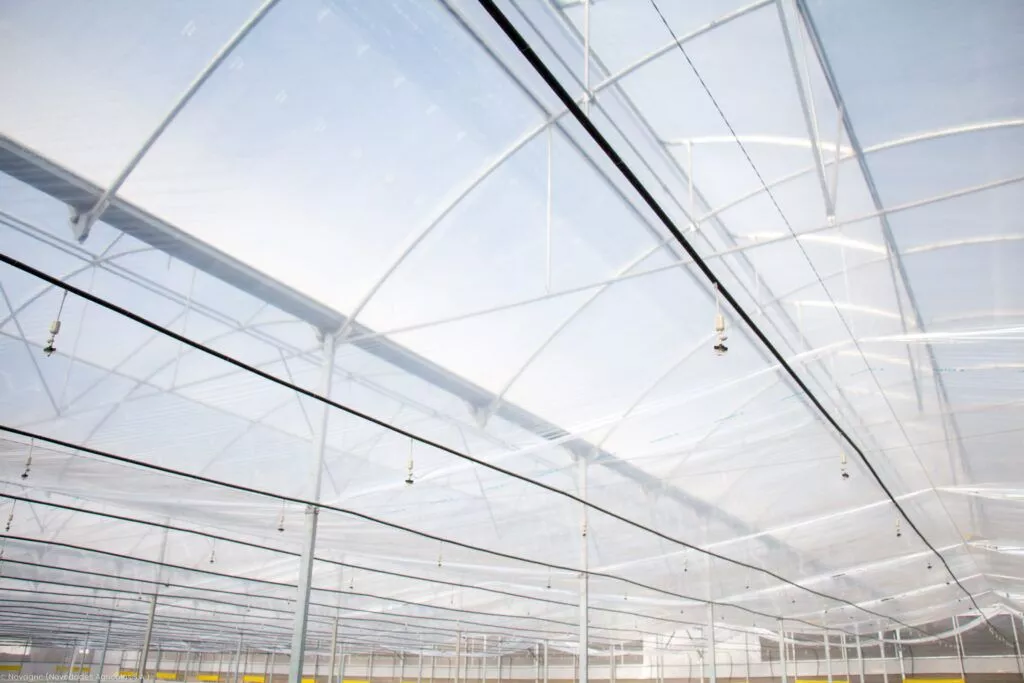
Elements of micro-sprinklers:
Arch: avoids dripping and shaded areas (favours uniformity of irrigation).
Anti-fogging device: reduces the jet exit velocity and produces larger droplets (less wind dispersion).
less dispersed by the wind).
Flow regulator: keeps the flow rate of the micro-sprinkler constant within a range of pressures (self-compensating).
(self-compensating).
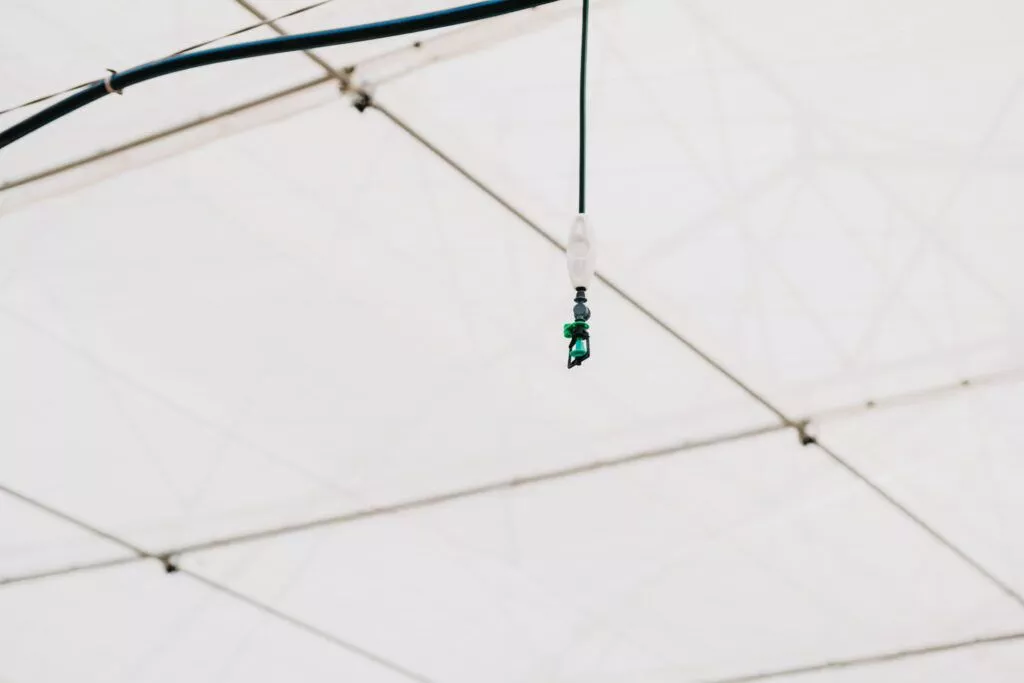
How to choose the right micro-sprinkler?
Choose the type of nozzle according to the flow rate you need.
Take into account the operating pressure (typically between 1.5 and 2 bar).
The spacing between micro-sprinklers has to coincide with their range.
Check line spacing and installation mode.
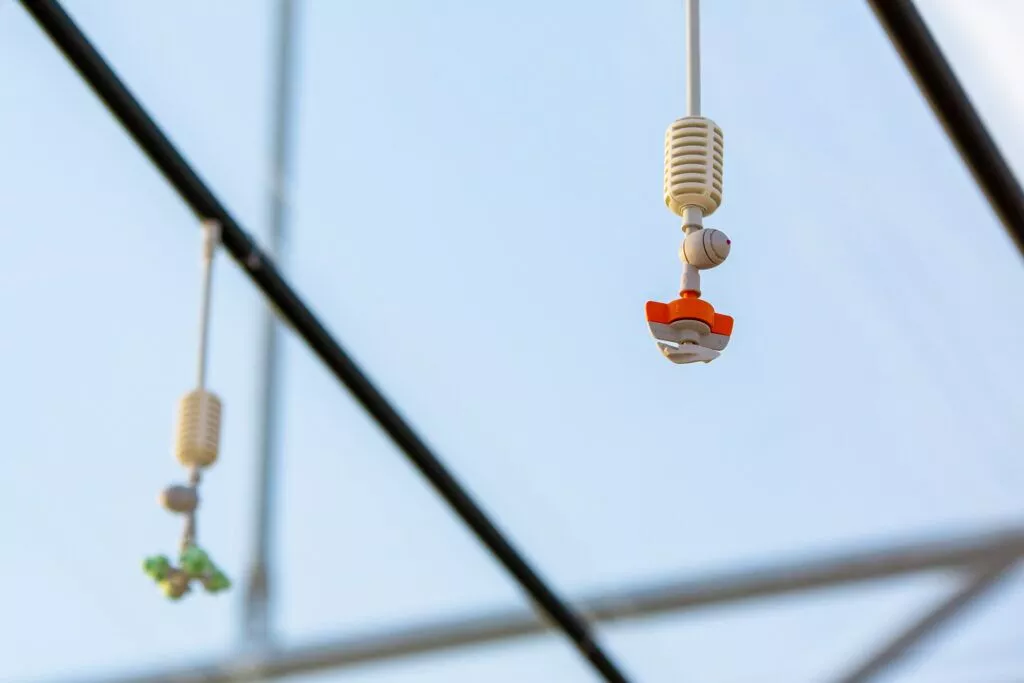
Irrigation pipes
They form the network of pipes that supply water for localised and sprinkler irrigation. The diameter of each pipe
depends on the flow rate it supplies and is divided into:
-
Primary pipe (larger diameter).
-
Secondary piping.
-
Tertiary piping.
-
Emitter-holding pipe (smaller diameter).
Scheme of a localised irrigation network
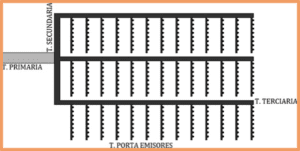
The design of the pipe network depends on the surface area of the property:
-
Small farms: emitter carrier pipes are installed on the primary pipe.
-
Large farms: require quaternary pipes to which the emitter holders are connected.
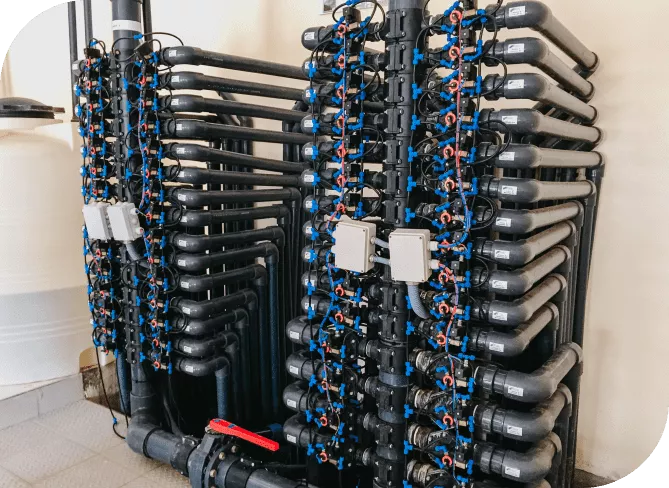
Irrigation pipe materials
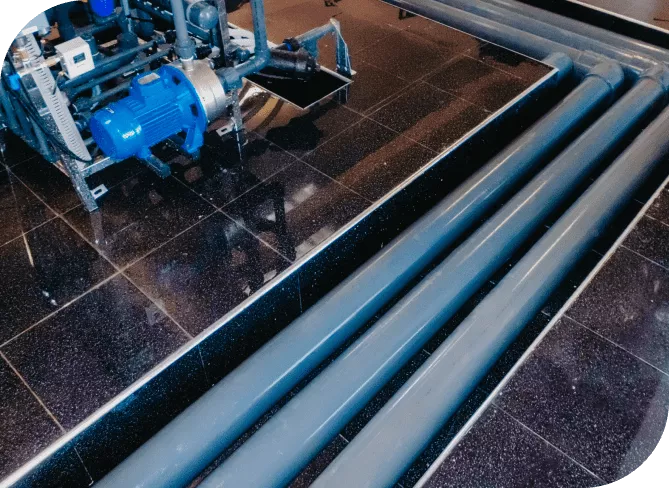
Fertiliser tanks
They are installed in irrigation heads to dilute chemical fertilisers and apply them together with the irrigation..
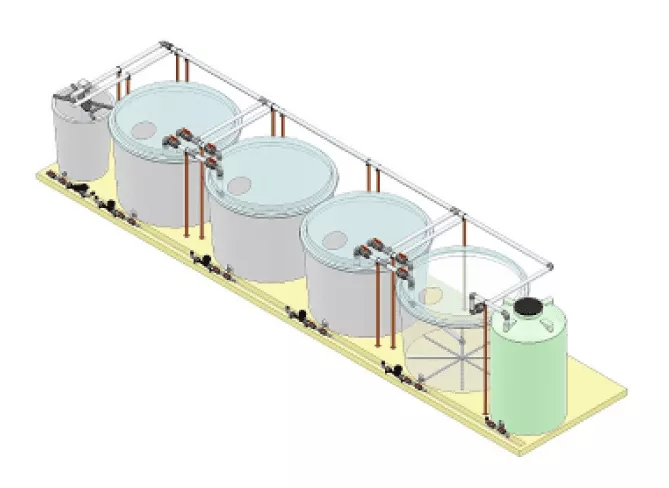
Installation of fertiliser tanks
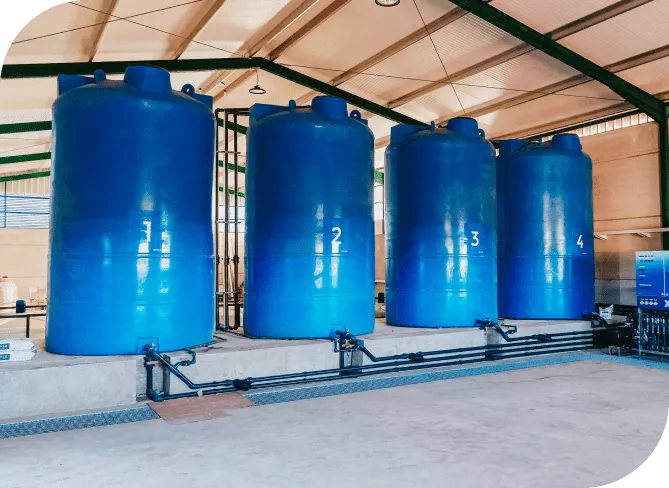
The number of tanks to be installed depends on the required use of your farm. The reason for using several tanks is to avoid chemical interactions between fertilisers (some are incompatible). Usually four tanks are installed for fertilisers and one for special inputs (acids or organic compounds).
Types of tank agitation systems
- Mechanical agitators: the motor shaft causes the rotation of a propeller which agitates the solution in the tank.
- Pneumatic agitators: a blower pump connected to a piping system injects air into the solution and agitates it.
Connection to injection devices:
- Venturi injectors.
- Metering pumps.
How can we help you?
Please complete the form below and we will contact you to find a solution adapted to your needs.

BASIC INFORMATION ON DATA PROTECTION: Data Controller: Novedades Agrícolas S.A. informs you that, in accordance with the European regulation on data protection 2016/679 of the European Parliament and of the Council of 27 April 2016 on the protection of personal data (RGPD), the controller of the personal data you provide is Novedades Agrícolas S.A. Purpose: The purpose of processing the personal data we request is to respond to your requests and provide you with our services. Advertising: We will only send you advertising with your prior authorization, which you can provide us with by means of the corresponding confirmation, established for this purpose, in this form. Legitimation: We will only process your data with your prior consent, which you can provide us with by means of the corresponding confirmation box established for this purpose. Addressees: In general, only duly authorized personnel of our entity may have knowledge of the requested information. Rights: You may exercise your rights of access, rectification, limitation or elimination of such data through [email protected]. Additional information: You can consult additional and detailed information on Data Protection in our privacy policy.


